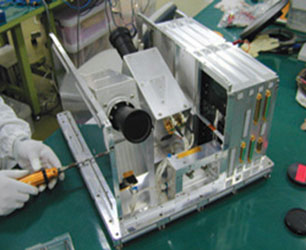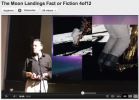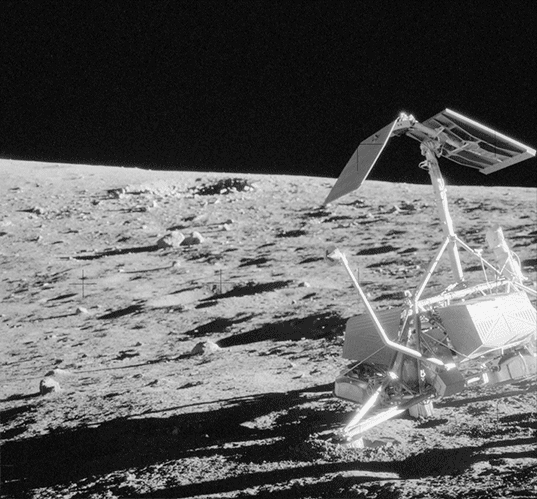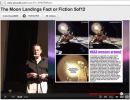It looks like you're using an Ad Blocker.
Please white-list or disable AboveTopSecret.com in your ad-blocking tool.
Thank you.
Some features of ATS will be disabled while you continue to use an ad-blocker.
share:
reply to post by Soylent Green Is People
In some of the LRV paths that are photographed, they drove BACK over the way the way them had come previously.
Some of it simply to be absolutely certain that what they were using to navigate with was accurate....(to go home) ....and partly, if out of sight of their objective (the Lunar Module) due to terrain issues, well.....self-preservation logistics, naturally!!
There was no "luxury" back then like GPS....once out of sight of their "safe" place, the reliance on the inertial guidance of the LRV systems? I'd want to have a visual way "back", just-in-case.....too.
In some of the LRV paths that are photographed, they drove BACK over the way the way them had come previously.
Some of it simply to be absolutely certain that what they were using to navigate with was accurate....(to go home) ....and partly, if out of sight of their objective (the Lunar Module) due to terrain issues, well.....self-preservation logistics, naturally!!
There was no "luxury" back then like GPS....once out of sight of their "safe" place, the reliance on the inertial guidance of the LRV systems? I'd want to have a visual way "back", just-in-case.....too.
reply to post by SayonaraJupiter
HD TV does not define high resolution imagery. What would define resolution is pixels per inch, centimeter, millimeter, nanometer, and so on. Resolution requires at least two variables, physical size ie. inch, mili, and so on, and pixels per that measurement. You can't say HI Def, or 300 dpi because that is meaningless without the other variable parameter. High to WHAT!?
The GRAIL mission is a small NASA mission to map the gravitational variations of the moons geology, the MoonKam is but a near end mission addition, and like Phage said they are but tiny cameras, like in a 7-11 security cam or what you can buy for 80 bucks. Its an outreach program to get young people involved in the space program, maybe to pay attention more in science classes.
Here's the tiny washing machine sized GRAIL spacecrafts.
Here are the cameras the kids can request viewing areas from.
There is no documented resolution of the cameras that I could find yet but they will have an orbital altitude of as low as 35 miles above the lunar surface, about as low as the LRO lunar satellite but have less computing and transferring power which also will be using the LRO to transmit images back to earth, I seriously doubt they will have a greater resolution for this rathe brief mission objective of GRAIL. GRAIL has a mission window of just 8 months before the sun will disrupt what is is sent to sensor. Photography is os little mission objective, but having school kids suggest areas, and actually be selected is like one of those MasterCharge ad, priceless.
However the GRAIL is equipped with extremely accurate altimeter sensors that WILL provide a higher surface 3D MAPPING information to also assist with the below surface mineral detection equipment, and should as far as it covers, provide a better 'Google Moon' surface altitude data than the best so far which I believe was JAXA's SELENE, by at least 10x. Stay tuned, the kids can point the cameras in March, and the imagery will be posted on the site Phage linked.
BTW if you want better imagery of specific spots on the moon, GRAIL costs about half a billion, and then you'd have to support larger higher def cameras, more fuel, and a larger launch heavy lift rocket, which should boost your cost to around a billion dollars for pictures you still will dispute. So save up or become really good friends with Gates or somebody who might have that money and more importantly, that give a crap.
It's really up to you, what's holding YOU back?
HD TV does not define high resolution imagery. What would define resolution is pixels per inch, centimeter, millimeter, nanometer, and so on. Resolution requires at least two variables, physical size ie. inch, mili, and so on, and pixels per that measurement. You can't say HI Def, or 300 dpi because that is meaningless without the other variable parameter. High to WHAT!?
The GRAIL mission is a small NASA mission to map the gravitational variations of the moons geology, the MoonKam is but a near end mission addition, and like Phage said they are but tiny cameras, like in a 7-11 security cam or what you can buy for 80 bucks. Its an outreach program to get young people involved in the space program, maybe to pay attention more in science classes.
Here's the tiny washing machine sized GRAIL spacecrafts.
Here are the cameras the kids can request viewing areas from.
There is no documented resolution of the cameras that I could find yet but they will have an orbital altitude of as low as 35 miles above the lunar surface, about as low as the LRO lunar satellite but have less computing and transferring power which also will be using the LRO to transmit images back to earth, I seriously doubt they will have a greater resolution for this rathe brief mission objective of GRAIL. GRAIL has a mission window of just 8 months before the sun will disrupt what is is sent to sensor. Photography is os little mission objective, but having school kids suggest areas, and actually be selected is like one of those MasterCharge ad, priceless.
However the GRAIL is equipped with extremely accurate altimeter sensors that WILL provide a higher surface 3D MAPPING information to also assist with the below surface mineral detection equipment, and should as far as it covers, provide a better 'Google Moon' surface altitude data than the best so far which I believe was JAXA's SELENE, by at least 10x. Stay tuned, the kids can point the cameras in March, and the imagery will be posted on the site Phage linked.
BTW if you want better imagery of specific spots on the moon, GRAIL costs about half a billion, and then you'd have to support larger higher def cameras, more fuel, and a larger launch heavy lift rocket, which should boost your cost to around a billion dollars for pictures you still will dispute. So save up or become really good friends with Gates or somebody who might have that money and more importantly, that give a crap.
It's really up to you, what's holding YOU back?
reply to post by SayonaraJupiter
Oh HOW pathetic!!!!!:
What utter grasping at straws!!! It's a freaking CAMERA, not a "magic box"!!
AND the film it contained was LONG AGO developed and made public.
Oh HOW pathetic!!!!!:
Or Ed Mitchell's Data Acquisition Camera, now that NASA has it back in their own custody.
What utter grasping at straws!!! It's a freaking CAMERA, not a "magic box"!!
AND the film it contained was LONG AGO developed and made public.
BTW, HDTV doesn't even fill my computer monitor width, (I have HD TV on my computer, for football game recordings/internet streaming/forum
discussions), which is 4 times the resolution of the TV screen, 720P appears about 6 inches wide on my monitor. HDTV, or 1080p is not very high
resolution for a graphic artist, it's barely high enough for a magazine image on a single page width. It might look kinda clear because you view a
large screen TV from several feet away. Film negatives from 60's Apollo Hasselblad cameras have a resolution of about 2,400 pics per inch, and I
believe the negs were 4x5 inches–medium format cameras. Film will always be a higher resolution than any digital imagery, you can look up for
yourself the film grain.
Hasselblad in Space
Hasselblad in Space
Originally posted by SayonaraJupiter
HDTV en.wikipedia.org...
HDTV? That doesn't really make a lot of sense. HDTV resolutions are still pretty low and don't even compare to the images taken by LRO and other orbiting probes. The highest HD resolution is 1920x1080 pixels. If you've ever downloaded an image from the LROC site, you'd know it's much larger than that. But the resolution is meaningless without adequate magnification and there are physical limitations to how big of a telescope you can use.
But to reiterate what ngchunter said, define the resolution you demand in meters per pixel.
Or Ed Mitchell's Data Acquisition Camera, now that NASA has it back in their own custody.
What does this have to do with anything?
Originally posted by ProudBird
reply to post by Soylent Green Is People
In some of the LRV paths that are photographed, they drove BACK over the way the way them had come previously. ...
Thanks for the info.
I see some rover tracks are darker than others, which I assumed was due to different shadow conditions (variations to the slope of the surface = different sun angles), but maybe some are darker because -- as you pointed out -- they drove over the same path more than once.
I assumed that the path leading to the final parking spot of the rover was only a single-time path (it is very light and harder to see). I suppose it may also be true that the swath cut in the lunar soil by the 8.4" tires is wider than 8.4". Add 1.5 inches or so on both sides for disturbed soil, and the track could be almost 1 foot wide.
There was no "luxury" back then like GPS....once out of sight of their "safe" place, the reliance on the inertial guidance of the LRV systems? I'd want to have a visual way "back", just-in-case.....too.
The rover DID have its own "GPS" of sorts. Well, not really a GPS, but a navigation system that would tell them where they were. The LRV's navigation computer would use pitch and roll data gathered by an on-board gyroscope, which would work in tandem with the sun-angle indicator on the LRV (information inputted manually) to allow the navigation computer to calculate the Lunar rover's heading. The LRV nav computer could tell the, their heading with respect to Lunar North and also give them a three-digit angle bearing.
The system wasn't as accurate as GPS, but did work well enough. By Apollo 17, they felt confident enough in the rover to do a more "round-about" traverse that didn't include back-tracking, as the Apollo17 LRV traverse map in the below link indicates:
Apollo 17 LRV Traverse Map
Besides the navigation computer, they would navigate the LRV using visual landmarks.
edit on 12/23/2011 by Soylent Green Is People because: (no reason given)
reply to post by Illustronic
Phage didn't say anything like that.
Sorry about the communication breakdown here, but, what are you trying to accomplish, to deny ignorance or promote it? 80 dollar security cams from 7-11???
And please to add the source links to the GRAIL camera pics you posted... it's not that I don't believe you about the GRAIL cameras but it's much better that I (and everyone else reading) can review the page you took them from. Thanks in advance.
Illustronic said: like Phage said they are but tiny cameras, like in a 7-11 security cam or what you can buy for 80 bucks.
Phage didn't say anything like that.
Phage said: No. The cameras were not requested by students. The outreach project was proposed by Sally Ride.
Students are allowed to request specific targets for the cameras. Pretty cool way to stimulate an interest. The cameras are pretty tiny things. www.abovetopsecret.com...
Sorry about the communication breakdown here, but, what are you trying to accomplish, to deny ignorance or promote it? 80 dollar security cams from 7-11???
And please to add the source links to the GRAIL camera pics you posted... it's not that I don't believe you about the GRAIL cameras but it's much better that I (and everyone else reading) can review the page you took them from. Thanks in advance.
reply to post by SayonaraJupiter
Phage gave you the source, just shows people don't go to links provided. My point was that the GRAIL mission will not provide better images than the LRO no matter who wants it to point at something. You want better, gather up about a billion bucks, contract a heavy lift somewhere, shoot it to the moon with a good guidance team of support, or you just might miss orbit like the Russians did over and over in the 60's, if they can even reach earth escape velocity, which seems to challenge their skills yet even today.
I closed all of my sources from an easy search, not going backwards for you. How hard is it to type in GRAIL mission MoonKam specs?
BTW Phage said the cameras are little, I added the 7-11 security thing myself, which as you see they are, small, like security cams they sell on the web, small means small, not large. Which is why I decided to illustrate them, since people don't check out links.
Phage gave you the source, just shows people don't go to links provided. My point was that the GRAIL mission will not provide better images than the LRO no matter who wants it to point at something. You want better, gather up about a billion bucks, contract a heavy lift somewhere, shoot it to the moon with a good guidance team of support, or you just might miss orbit like the Russians did over and over in the 60's, if they can even reach earth escape velocity, which seems to challenge their skills yet even today.
I closed all of my sources from an easy search, not going backwards for you. How hard is it to type in GRAIL mission MoonKam specs?
BTW Phage said the cameras are little, I added the 7-11 security thing myself, which as you see they are, small, like security cams they sell on the web, small means small, not large. Which is why I decided to illustrate them, since people don't check out links.
edit on 23-12-2011 by
Illustronic because: (no reason given)
reply to post by Illustronic
Further GRAIL camera info:
eclipticenterprises.com...
PR-quallity. If you wanna call that a 7-11 security cam. It seems a more expensive than $80 dollars. I know NASA always overpays for their space cameras. I didn't find any specs on their webpage.
edit to add: comparison picture of Kaguya's HDTV which can be found at this link : www.jaxa.jp...

Further GRAIL camera info:
eclipticenterprises.com...
You don't need a high-end, expensive, science-quality imaging system. RocketCam™ systems provide engineering and PR-quality situational awareness within a small, rugged, cost-effective package, and are available in analog (Analog Video Systems, AVS), digital (Digital Video System, DVS), and hybrid analog-digital configurations (Integrated Video Assembly, IVA).
PR-quallity. If you wanna call that a 7-11 security cam. It seems a more expensive than $80 dollars. I know NASA always overpays for their space cameras. I didn't find any specs on their webpage.
Typical system lifetimes for the most demanding applications, space, are hours to months to several years. Selected systems have been ruggedized further to allow for addional tolerance to space-radiation effects, enabling lifetimes of 5 years or more.
edit to add: comparison picture of Kaguya's HDTV which can be found at this link : www.jaxa.jp...

edit on 12/24/2011 by SayonaraJupiter because: add kaguya comparison
This is the exact moment that Marcus Allen says "PR images from the moon".

He explains that it is impossible to have that reflection on his boot. He is arguing that this is a manufactured studio image. Part 4 of 12 is here www.youtube.com...

He explains that it is impossible to have that reflection on his boot. He is arguing that this is a manufactured studio image. Part 4 of 12 is here www.youtube.com...
And here is where Marcus Allen says "The laws of perspective do not work this way." Is it Proof We Didn't Go To The Moon? Or is it simply proof that
we didn't go to the Moon in the same exact way that NASA reported it?
www.youtube.com...

www.youtube.com...

edit on 12/24/2011 by SayonaraJupiter because: (no reason given)
reply to post by SayonaraJupiter
No, he claims it is impossible. He also ridicules the way Aldrin comes down the ladder. How would you go down a ladder in a stiff spacesuit in 1/6 g? Oh, and also claims the shots are composed perfectly. They don't look perfect to me. He also marvels that they are exposed properly. Why shouldn't they be? The professional photographs bracket photographs because they use a wider rang of f-stops than the astronauts did, so they are concerned about depth of field. The astronauts didn't have to worry about that. Shall I go on?
Incidentally, he is a welcome relief from a certain obnoxious YouTube user. His voice is gentle, soothing and, frankly, has cured me of my insomnia for the night.
He explains that it is impossible to have that reflection on his boot. He is arguing that this is a manufactured studio image. Part 4 of 12 is here www.youtube.com...
No, he claims it is impossible. He also ridicules the way Aldrin comes down the ladder. How would you go down a ladder in a stiff spacesuit in 1/6 g? Oh, and also claims the shots are composed perfectly. They don't look perfect to me. He also marvels that they are exposed properly. Why shouldn't they be? The professional photographs bracket photographs because they use a wider rang of f-stops than the astronauts did, so they are concerned about depth of field. The astronauts didn't have to worry about that. Shall I go on?
Incidentally, he is a welcome relief from a certain obnoxious YouTube user. His voice is gentle, soothing and, frankly, has cured me of my insomnia for the night.
I'm not going to watch a half of an hour of some skeptic's misunderstanding of scattered light and depth perception on the moon in photographs, like
I mentioned earlier its simple poor understanding of lunar photos not being the same as on earth, you need more data than a poor analysis of
photographic images from Apollo to prove they are not genuine.
Here,
What he fails to understand is the distance that crater is and depth perception doesn't exist on the moon with no atmosphere, things in the distance aren't going to fade through atmospheric haze, a hill miles away will be as clear as a rock 10 meters away, which is about all you need to set the camera focal length to infinity, called the hyperfocal distance. For less manual camera fiddling, the astronauts always had the focal set to infinity. When images are shot at infinity background and foreground will both be in focus, with no atmospheric haze. The two photos were simply taken from two different distances. That's photography 101.
Here,
What he fails to understand is the distance that crater is and depth perception doesn't exist on the moon with no atmosphere, things in the distance aren't going to fade through atmospheric haze, a hill miles away will be as clear as a rock 10 meters away, which is about all you need to set the camera focal length to infinity, called the hyperfocal distance. For less manual camera fiddling, the astronauts always had the focal set to infinity. When images are shot at infinity background and foreground will both be in focus, with no atmospheric haze. The two photos were simply taken from two different distances. That's photography 101.
Here's a crude animation of what I'm talking about, the eye level is high so the round black disc indicating a crater can be seen more easily. Again
crude with poor camera tracking but gets the point across. Also if I used a greater distance to the background, it would have the mountain and crater
virtually not change in size, so excuse the fast production.
Originally posted by SayonaraJupiter
In regards to the image above. Here are the two photos, with the crater aligned and animated.

Clearly the crater isn't exactly the same in both images. It changes, it gets a little larger, the angle at which we see the crater changes as well. Obviously this guy hasn't looked hard enough at the photos.
This guy hasn't presented any evidence, let alone proof, of anything. He merely offers an opinion with nothing to back it up. Just a few minutes in photoshop clearly shows that he is wrong in his opinion of the crater.
edit on 24-12-2011 by jra because: (no reason given)
reply to post by Soylent Green Is People
Oh yes, I realized this from my research:
But, as you said....each time they gained more confidence in the system. I think, depending on the EVA mission plan, simply re-tracing their own tracks was also just easier. Certainly fool-proof!
Also, I am certain that the planning for LRV EVAs included the possibility that if the Rover failed for any reason, they still had a safety margin for the contingency of "walking" back to the ship.
Oh yes, I realized this from my research:
Well, not really a GPS, but a navigation system that would tell them where they were.
But, as you said....each time they gained more confidence in the system. I think, depending on the EVA mission plan, simply re-tracing their own tracks was also just easier. Certainly fool-proof!
Also, I am certain that the planning for LRV EVAs included the possibility that if the Rover failed for any reason, they still had a safety margin for the contingency of "walking" back to the ship.
new topics
-
Potter to WHU
World Sports: 14 minutes ago -
Dr. Demento
Music: 2 hours ago -
The elephant in the room (wearing a hoodie)
US Political Madness: 2 hours ago -
To become president, Zelensky had to learn Ukrainian
Political Conspiracies: 8 hours ago
top topics
-
Green Grapes
General Chit Chat: 12 hours ago, 6 flags -
To become president, Zelensky had to learn Ukrainian
Political Conspiracies: 8 hours ago, 5 flags -
The elephant in the room (wearing a hoodie)
US Political Madness: 2 hours ago, 5 flags -
Those Great Fresh Pet Commercials
Television: 17 hours ago, 3 flags -
Dr. Demento
Music: 2 hours ago, 2 flags -
Potter to WHU
World Sports: 14 minutes ago, 1 flags
active topics
-
The elephant in the room (wearing a hoodie)
US Political Madness • 8 • : xuenchen -
To become president, Zelensky had to learn Ukrainian
Political Conspiracies • 8 • : WaESN -
Potter to WHU
World Sports • 1 • : gortex -
Dr. Demento
Music • 3 • : xuenchen -
Green Grapes
General Chit Chat • 4 • : AlroyFarms -
Los Angeles brush fires latest: 2 blazes threaten structures, prompt evacuations
Mainstream News • 125 • : xuenchen -
Steering the Titantic from the Drydock.
Rant • 44 • : ufoorbhunter -
Those Great Fresh Pet Commercials
Television • 5 • : CosmicFocus -
Planned Civil War In Britain May Be Triggered Soon
Social Issues and Civil Unrest • 23 • : AdultMaleHumanUK -
Those stupid GRAVITE commercials
Rant • 14 • : FlyersFan

